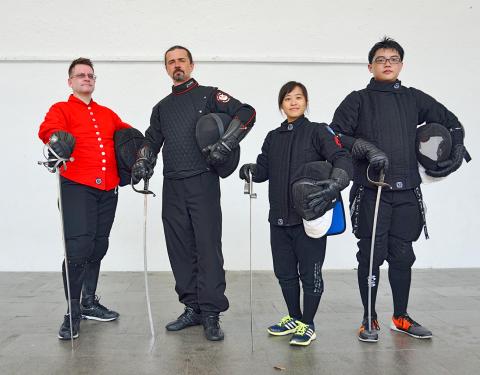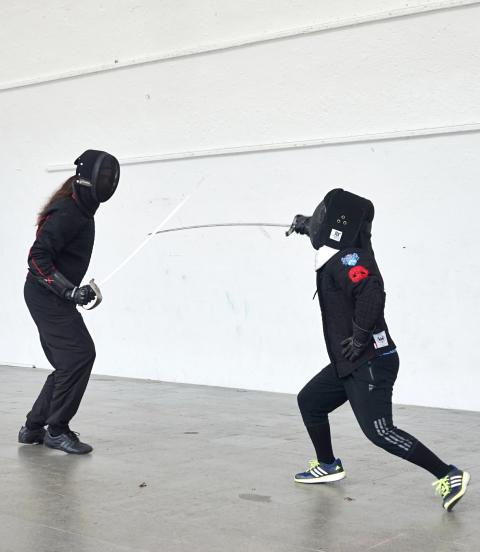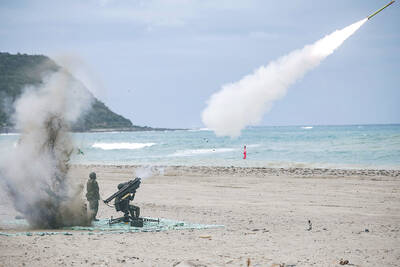If you ever wanted to witness a duel with real French small swords, say, or Italian sabers, the Lionheart Historical European Swordsmanship club will be holding a public training session outside the concert hall of Chiang Kai-shek Memorial Hall tomorrow where all are welcome to watch. The club practices at least twice monthly.
Huang Chun-yi (黃郡儀), the club’s founder, grew up watching movies such as Lord of the Rings and Kingdom of Heaven and read books like Alexandre Dumas’ The Three Musketeers. When she was older, she did some research about fencing and found a trove of historical fencing manuals online.
“I started my practice with a stick,” the 25-year-old tells the Taipei Times.

Photo: Dana Ter, Taipei Times
Huang joined her university’s fencing club before founding the Lionheart Historical European Swordsmanship club in 2014. While Historical European Martial Arts (HEMA) has been practiced in Europe for decades, it’s just recently gained traction in Taiwan.
The difference between Olympic-style sports fencing and HEMA, Huang says, is that while the goal of the former is to score points, the latter seeks to recreate various styles of European sword fighting over the last few centuries with real steel weapons modeled closely after historical weapons. Competition and spectatorship is de-emphasized in HEMA, which is regarded by its practitioners as more of a hobby and for the purpose of preserving tradition through recreating duels and combat moves.
The club imports most of their swords from the Ars Dimicatoria (which is Latin for “Art of Fencing”), a HEMA school based in Prague. Michael Knazko, an instructor from the school, was in Taipei last month to train members of the club. Needless to say, the club tends to attract history buffs, and many members also have experience in Chinese martial arts, kendo or sports fencing.

Photo: Dana Ter, Taipei Times
We come to HEMA “wanting something closer to what the warriors of old have done,” says club member Kevin Yang (楊凱文).
He has a pdf file of the 14th-century Italian knight and fencing master Fiore dei Liberi’s fencing manual, Fior di Battaglia (“The Flower of Battle”), on his smartphone, which he tries to study regularly.
“We seek authenticity in HEMA,” Yang adds.
In addition to using weapons modeled after historical ones, HEMA practitioners worldwide also try to mimic the techniques and moves of ancient European swords masters as closely as possible.
Club member Jonathan Burke points out that this is what distinguishes HEMA from live action role-playing (LARP) or cosplay: “In HEMA, you’re not a fictional character, you’re recreating and perpetuating a historical tradition.”
He adds that safety is taken seriously in the club and that it’s ensured by various factors including several layers of protective clothing and a deliberate restraint of force.
Event notes
What: Lionheart Historical European Swordsmanship (獅心歷史歐洲劍術) training session
When: Tomorrow from 9:30am to noon
Where: Chiang Kai-shek Memorial Hall (中正紀念堂), 21-1 Zhongshan S Rd, Taipei City (台北市中山南路21-1號)
Admission: Free
On the net:www.facebook.com/leohistoricaleuropeanswordsmanship

In late October of 1873 the government of Japan decided against sending a military expedition to Korea to force that nation to open trade relations. Across the government supporters of the expedition resigned immediately. The spectacle of revolt by disaffected samurai began to loom over Japanese politics. In January of 1874 disaffected samurai attacked a senior minister in Tokyo. A month later, a group of pro-Korea expedition and anti-foreign elements from Saga prefecture in Kyushu revolted, driven in part by high food prices stemming from poor harvests. Their leader, according to Edward Drea’s classic Japan’s Imperial Army, was a samurai

The following three paragraphs are just some of what the local Chinese-language press is reporting on breathlessly and following every twist and turn with the eagerness of a soap opera fan. For many English-language readers, it probably comes across as incomprehensibly opaque, so bear with me briefly dear reader: To the surprise of many, former pop singer and Democratic Progressive Party (DPP) ex-lawmaker Yu Tien (余天) of the Taiwan Normal Country Promotion Association (TNCPA) at the last minute dropped out of the running for committee chair of the DPP’s New Taipei City chapter, paving the way for DPP legislator Su

It’s hard to know where to begin with Mark Tovell’s Taiwan: Roads Above the Clouds. Having published a travelogue myself, as well as having contributed to several guidebooks, at first glance Tovell’s book appears to inhabit a middle ground — the kind of hard-to-sell nowheresville publishers detest. Leaf through the pages and you’ll find them suffuse with the purple prose best associated with travel literature: “When the sun is low on a warm, clear morning, and with the heat already rising, we stand at the riverside bike path leading south from Sanxia’s old cobble streets.” Hardly the stuff of your

Located down a sideroad in old Wanhua District (萬華區), Waley Art (水谷藝術) has an established reputation for curating some of the more provocative indie art exhibitions in Taipei. And this month is no exception. Beyond the innocuous facade of a shophouse, the full three stories of the gallery space (including the basement) have been taken over by photographs, installation videos and abstract images courtesy of two creatives who hail from the opposite ends of the earth, Taiwan’s Hsu Yi-ting (許懿婷) and Germany’s Benjamin Janzen. “In 2019, I had an art residency in Europe,” Hsu says. “I met Benjamin in the lobby